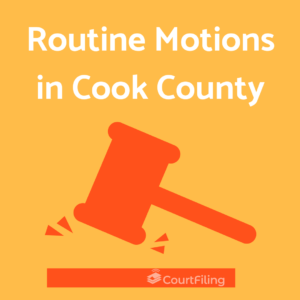In Cook County, a “routine” motion is a basic, general motion. An attorney would file a routine motion to get permission from the judge to use a simple procedure to move the case along. Routine motions are mostly technical or procedural in nature. For example, a Motion to Appoint a Special Process Server is a routine motion filed to get permission to use a private process server to serve a lawsuit.

The judge normally grants a routine motion without a hearing, unless there is an objection to the motion. If there is an objection, then no court order is entered and the party that originally filed the motion (the “movant”) will now have to schedule it for hearing on the regular motion calendar.
In some cases, the movant may deliver copies of the motion, along with copies of a proposed order, in the judge’s courtroom and pick up a signed order at a later time. A proposed order is a pre-filled order, usually prepared by the movant, to grant what the motion asks for.
A routine motion is usually granted with no objection. They are so regularly granted that the judges have developed standard, consistent procedures for handling these types of motions. Those standard operating procedures are compiled into a document called a Standing Order. A routine motion usually does not need to be filed or scheduled for a hearing with the clerk, however, best practice is to check the Standing Order of the judge assigned to your case to determine how that judge handles routine motions.
You can find a judge’s Standing Order online on the Cook County Judge’s page. Listed within the Standing Order is also a list of what the judge considers “routine motions”. On the whole, the Law Division and Chancery Division judges are the ones who typically have Standing Orders.
Generally, before mandatory eFiling, the movant would review the judge’s Standing Order and determine the day and time when routine motions could be heard before that particular judge. The movant would then physically take copies of the motion, notice of motion (if required by that particular judge), and a proposed order granting the motion to the judge’s courtroom. The judge’s clerk would review the routine motion and enter the proposed order by stamping the order as “filed.”
Routine motions must now be electronically filed, but it is still not necessary to schedule a hearing date. Depending on the judge’s Standing Order, you will need to eFile just the motion. Then, once accepted by the clerk, take a copy of the file-stamped motion and copies of a proposed order to the judge’s courtroom, where the order would be stamped by the judge’s clerk and subsequently entered on to the court’s docket.
Insider tip: Orders are exempt from the eFiling mandate at this time and any order entered in the courtroom will also be handled by the judge’s clerk to ensure that the order is entered and added on the docket.
If your routine motion is not accepted in time to take a copy to the judge’s courtroom at the designated time, be sure you take a copy of the email showing that the motion was submitted for eFiling.
Share This Post
Support ArticlesFind answers in our extensive directory of help articles. |
|
Live ChatOur most popular support option. Connect with us right away. |
|
(801) 448-7268Call us Monday through Friday between the hours of 7:00 AM to 7:00 PM PST. |